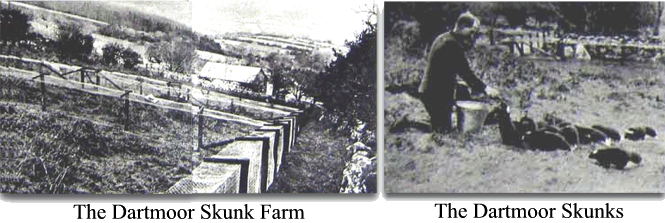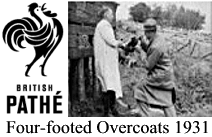
Over the years there have been many kinds of farms established on Dartmoor and in latter years have been concerned with various non-native breeds. Probably the most unexpected was one that appeared in the early 1920s and involved skunk breeding. Normally the skunk is probably one of the last animals whose coat one would want to borrow and consider as a fashion accessory. However, back then fur coats were the accepted norm and a skunk pelt was renown for being soft and subtle making them ideal for making hats and coats.
The first skunk farm in the United Kingdom was set up in 1913 and was based in the Cheviot Hills in Northumberland by one Colonel M. L. Chute. Initially expert opinion was that this was a venture doomed to failure from the beginning. However, who dares wins and the Colonel proved them wrong by producing healthy litters which eventually produced pelts equally as good as those coming from America. Unfortunately for him the First World War put paid to any future development of the venture. Once the war had ended the venture rose from the ashes just like the proverbial Phoenix and in 1919 the British Fur Farms Ltd. was established.
In this same year Colonel Chute started another farm on Dartmoor and was known as the ‘Wild Pine Fur Ranchers’ at what today is Teigncombe Farm. The establishment was run by messrs. Colonel D. Pigot and Mr. C. J. Johnstone. The location chosen consisted of twenty five acres of larch and pine trees along with areas of rough moorland and was leased from the Duchy of Cornwall, all providing the idea habitat for the animals. The other benefit of this location was that standing at an altitude of 284 metres it provided a climate which induced the animals to grow thicker coats than lower and warmer locations would. The first skunk intake consisted of 66 animals some of which came from Northumberland and the rest imported from America and Canada.
To be of any use in the fir industry the pelts needed to have as little white fur as possible, however the wild skunk’s natural pelt consists of roughly 50% black fur and 50% white. Therefore the aim through careful selective breeding was to produce skunks with black pelts. By 1922 it was reported that there were around 190 skunks on the farm with plans to increase these numbers. In normal circumstances the skunks should be ready for killing at around nine months of age. However at the time the plan was to increase the numbers to four figures before any of them went to the furriers. In the 1920s skunk pelts were fetching anything between thirty shillings to two pounds which would have been a fair return. Incidentally, today a tanned North American skunk pelt will fetch around £20 and are used to produce amongst other things Scottish sporrans.

It seems that when the initial skunks were brought to the farm they completely exterminated all of the local rabbit population within the first twenty four hours. Having done a ‘proper job’ on the rabbits they then set to devouring all the mice and beetles within their confines. If nothing else this saved on initial feeding costs as they were too full of local wildlife to look at their feed rations. With regards to feeding, it seems that the skunks were fed once a day on cakes made from meat and vegetables or milk and water at a cost of 2½d per week for each skunk.
Skunks are naturally ‘promiscuous’ and do not select a mate which means they can be allowed to run around in groups. Ideally the ratios of males to females is 1 male for every 5 females. Mating begins around March and the gestation period is around 66 days with litters consisting of around 4 kits.
It is no secret that skunks are well known for their ability to secrete a foul and stinking liquid and so one would imagine that a skunk farm could never be the place to smell the bracing Dartmoor air. In order to prevent the farm’s locality becoming an exclusion zone the scent glands were removed on arrival. There was some suggestion at the time that the secretion may have provided some therapeutical uses and be of some commercial value, this avenue was not explored. Incidentally, this practice of de-scenting is now banned in Britain and the Royal College of Veterinary Surgeons deems it as unethical.
There is a short video of the fur farm made by Pathe news in 1931 which can be found at the link below. Here you will see various aspects of the skunk farm along with the ‘cute’ little furries themselves.
A few weeks ago I contacted the Duchy of Cornwall office in Princetown to see if they had any records or further information about the farm. Sadly they could find no mention of a skunk farm at Teigncombe but there was a letter dated the 30th of February 1922. Interestingly this stated that the then tenant of Teignhead Farm, one Mr. Phillpotts wanted to give up his lease. The letter goes on to suggest that Teignhead Farm; “might be very suitable for the people who propose to breed skunks.” It is then noted that; “Colonel Harrington is not at Dartmoor at the moment but he has some representative looking around the moor to find a suitable place for breeding. The profits of the business I am told are enormous and therefore you can quite fairly ask for a substantial rent for the farm.” – my thanks go to Anne Kelly from the Duchy’s Princetown office for her kind assistance.
I have now written to the Duchy of Cornwall archivist in London to see if they have anymore information on the skunk farm.
Not only was this farm to breed skunks but there were also plans to breed silver foxes and sables, all for their pelts. This silver fox initiative was also taken up by other farmers on Dartmoor such as that at the Peregrine Fur Farm near Moretonhampstead.
This page has now led to a short evening news piece on the local BBC Spotlight programme and radio station, all of which is told – HERE.
 Legendary Dartmoor The many aspects past and present of Dartmoor
Legendary Dartmoor The many aspects past and present of Dartmoor

